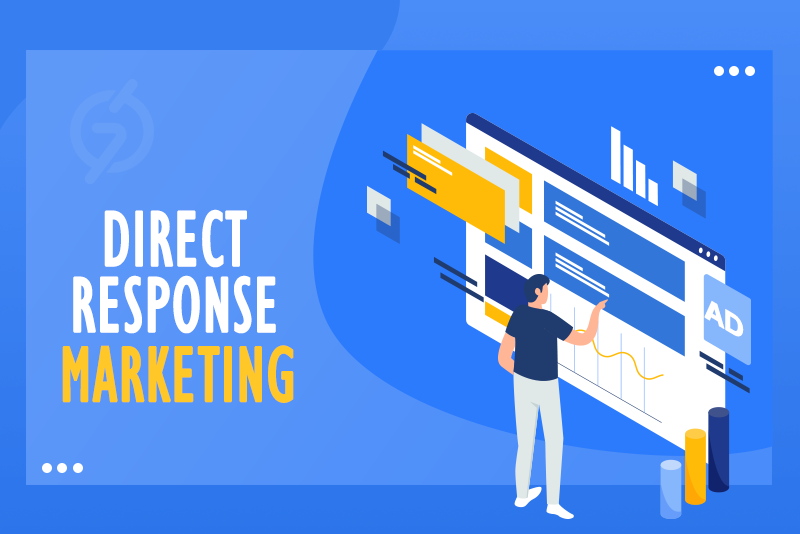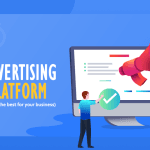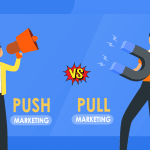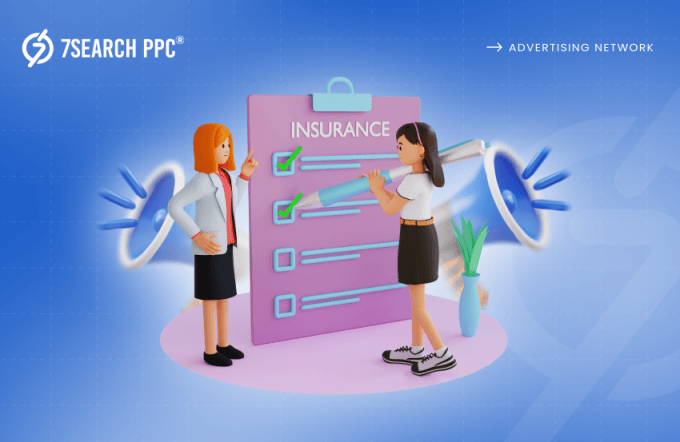If you want to know the importance of time, then ask marketers. They will tell you how crucial it is to seize every moment to engage customers. They go through long marketing procedures, whether it is launching a new product during peak season or capitalizing on a strategic event to maximize visibility and impact. These long processes do not guarantee positive results for advertisers despite the time they invest in them.
These long procedures hold back advertisers and diminish their marketing efforts. When positive results matter most, advertisers need a marketing strategy that cuts off the waiting time and provides instant, favorable outcomes. That’s where direct response marketing comes into play.
This powerful method is designed to get a quick response from potential customers, “Whether it’s purchasing an item, subscribing to a newsletter, or requesting more information. This guide is your one-stop solution for mastering DRM.
We’ll break down the “why” and “how” of this powerful strategy. We will also show you exactly how to craft campaigns that trigger immediate action and deliver the ROI your ad campaign deserves. Let’s begin!
Is Your Brand Stuck? Direct Response Marketing Can Help
Who wants to wait for a long time to get positive results when there is a way to get them quickly? Do you? We know that no one enjoys unnecessary delays in this competitive field where every second matters for marketers.
So, what will you do to cut through a long queue and make a direct connection with your ideal customers? Here, you need a direct response marketing strategy that uplifts your brand from being stuck to soaring success.
DRM is a marketing strategy that aims to prompt an instant response from potential customers rather than focusing on long-term brand building. This is achieved by presenting a clear offer and a compelling call to action (CTA), such as a discount, a free trial, or a chance to win a prize.
The main objective is to persuade viewers to take a particular action immediately, such as:
- Making a purchase
- Subscribing to a mailing list
- Downloading a white paper
Direct response marketing campaigns are frequently used in online advertisements ( PPC advertising) and email marketing. If you compare DRM with other marketing methods, you will find that tracking the ROI of direct response marketing campaigns is much easier.
Advantages Offered by Direct Response Marketing
DRM comes with a bundle of benefits that make it a compelling option for businesses. Here are some of the key advantages:
Targeted Audience Engagement
Direct response marketing lets you aim directly at people who are likely interested in what you offer. By targeting demographics, interests, behaviors, and other factors, you make sure your message connects with the right audience. This results in enhanced conversion rates and a more effective allocation of your marketing budget.
Measurable Results
Unlike some marketing methods, direct response campaigns are all about tracking and measuring results. You can see precisely the following:
- How many people responded to your offer
- Which messages were most effective
- Where you can optimize for better results
This data is invaluable for improving future marketing campaigns and enhancing your return on investment (ROI).
Cost-Efficiency
Direct response marketing, such as email or social media ads, is a cost-effective alternative to traditional methods. It enables you to reach a large audience without incurring high costs. By targeting your ideal customers, you can save money by not advertising to people who are unlikely to make a purchase.
Two-Way Communication
Communication between customers and marketers is very important for understanding needs and delivering effective solutions. Some marketing approaches only allow for one-way communication, in which marketers promote their offerings and can’t get immediate feedback from customers.
This way, they fail to adapt their strategies based on real-time customer insights. Direct response marketing is different as it fosters a more interactive experience with potential customers.
They can directly respond to your offers, ask questions, or request more information. This two-way communication helps you build relationships and guide potential buyers through the sales process.
Flexibility and Speed
Direct response marketing is flexible and lets you make changes quickly. If a campaign is not doing well according to your expectations, you can adjust your message, audience, or marketing channel to get better results. This flexibility helps you keep up with trends and make your marketing efforts effective.
Components of Direct Response Marketing
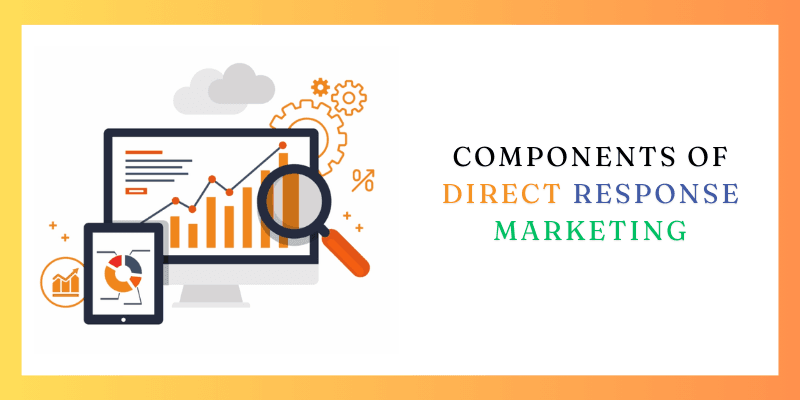
DRM aims to generate an instant response from consumers by including key components such as:
Irresistible Offer
Imagine delicious food in front of someone who’s hungry. That’s the power you want in your direct response offer. It should be so tempting that your target audience can’t ignore it. This could be a discount that saves money, a free trial that lets them experience the value before buying or a bonus that adds extra worth to their purchase.
The key is to understand their deepest desires and craft an offer that directly addresses those desires. This component makes them feel like they’d be missing out if they didn’t take action.
Compelling Message
The next component of direct response marketing that plays a crucial role in grabbing the eyes of the audience is compelling messages. Now, let’s understand why it is essential:
- It grabs attention in the first few seconds
- Builds interest by highlighting your audience’s problem
- Convinces the audience why your offer is the perfect solution
Clear Call To Action (CTA)
The simple meaning of CTA is giving someone directions. You wouldn’t just point them in the general direction and say, “Good Luck.” CTA functions the same way. It is important to clearly communicate the action you want your audience to take next. There is no room for confusion.
- Do you want them to visit your website?
- Download a white paper?
- Sign up for a free trial?
You can clearly direct your audience through CTA. The CTA’s you mostly find in direct response marketing are:
- “Shop Now”
- “Subscribe Today”
- “Claim Your Offer”
Accurate Targeting
Direct response marketing is like archery. You want your arrow to hit the right target, not get lost somewhere in the dark. That’s why targeting the right audience is crucial. Accurate targeting can be done in a quick time, but to understand the ideal customer profile, businesses take time for in-depth research like:
- Who are they?
- What are their demographics, interests, and pain points?
The more you know about your ideal audience, the better you can tailor your message and offer to resonate with them.
Proven Techniques for Effective Direct Response Marketing
DRM aims to get an immediate and measurable reaction from your audience. Here are some proven techniques to craft effective direct response marketing.
Create an Irresistible Offer
Direct response marketing success depends on how customers react after receiving your message. Your offer should directly address a pain point of your target audience. You should frame it in a way that highlights the benefits they’ll receive. This could be a discount, free trial, valuable information, or exclusive access. Remember, a strong offer removes hesitation and entices them to take action.
Target Your Message Sensibly
Remember that not everyone is your ideal customer. It’s important to focus on reaching people who are most likely to be interested in what you have to offer. Use demographics, interests, and online behavior to tailor your message to perfectly match a specific audience segment. This targeted approach will enable you to use your marketing budget more efficiently and achieve superior results.
Guide Your Customer to Completion
Friction is the enemy of conversion. You must ensure your direct responsive online ads or emails have a clear and concise call to action (CTA). Whether it’s a purchase, asking for a phone number, or form submission, make the next step effortless. The easier it is for potential customers to respond, the better your conversion rate will be.
A/B Test For the Best Combination
The success of direct response marketing is defined by achieving the optimal combination of its elements. Don’t take your step back to experiment! A/B testing permits advertisers to compare different versions of their direct responsive marketing ads to see which ones perform better.
You can test headlines, CTAs, visuals, and even offer details on a regular basis. This data-driven approach helps you optimize your ad campaigns and get the most out of your marketing efforts.
Scarcity and Urgency
People are more likely to take action when they feel that an opportunity is limited. You must highlight limited-time offers or limited quantities to create a sense of urgency. You can also use scarcity tactics by emphasizing exclusive content or early access. This strategy instills a sense of urgency and motivates potential customers to act before the offer expires.
Some Examples of Direct Responsive Marketing
Here are some popular examples of DRM campaigns you might encounter:
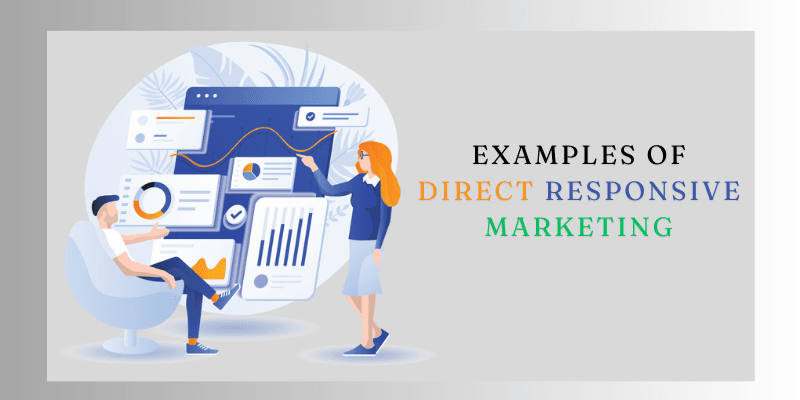
Pay-Per-Click (PPC) Advertising
PPC advertising is a prime example of direct response marketing, driving immediate results and targeted reach. Marketers bid for their responsive ads to appear when users search for specific keywords. PPC Advertising strengths lie in:
- Precision Targeting: Target potential customers who are actively seeking what you offer by focusing on relevant keywords.
- Compelling Ads: Craft clear, concise ad copy that entices users to click and engage.
- Optimized Landing Pages: Lead users to conversion-focused landing pages designed to get results.
- Clear CTAs: Tell users exactly what you want them to do with strong calls to action.
- Ad Extensions: Use ad extensions to showcase additional details and links, making your ad more appealing.
- Remarketing: Reconnect with website visitors who didn’t convert, keeping your brand top-of-mind.
- Track Results: Track user actions like purchases and form submissions to gauge success.
With PPC, you only pay when someone clicks your ad, making it a cost-effective way to generate leads and sales.
Social Media Advertising
Social media advertising is a great example of direct response marketing. Platforms like TikTok and Facebook, with their billions of active users, offer huge reach. However., the real power comes from the ability to target specific demographics. Marketers can focus on their ideal audience and create personalized messages that appeal to users who are likely to respond promptly to their offers and calls to action.
Additionally, the diverse ad formats and the ability to measure clicks, sign-ups, and purchases make social media advertising a powerful tool for generating immediate and measurable results in marketing campaigns.
Referral Programs
Direct response marketing uses strategies to prompt immediate action from your audience; Referral programs are one of them. This strategy harnesses word-of-mouth marketing. By encouraging existing customers to recommend your brand to friends and family, you tap into the trust people have in personal recommendations. This can be done through:
- Targeted emails
- Thank you pages after purchases
- Offering rewards like discounts or gifts for referrals.
These efforts build loyalty and grow your customer base naturally through satisfied customers’ trusted networks.
Email Campaigns
Email campaigns are the most trusted strategy in direct response marketing. They allow you to personalize messages to individual preferences and past behaviors. This personalization can be achieved through segmentation, targeting users based on demographics or purchase history, and using dynamic content that adapts to each recipient.
To drive action, craft clear subject lines that grab attention, keep content relevant and concise and include strong calls to action (CTAs).
Urgency tactics like limited-time offers can further incentivize clicks. Don’t forget the power of follow-up sequences, personalized recommendations, and feedback loops to keep users engaged.
Conclusion
Direct response marketing (DRM) is a quick and measurable way to connect with audiences and get them to act immediately. It focuses on clear offers, compelling messages, and targeting the right people, which helps increase conversion rates and ROI.
By using DRM, advertisers can quickly change their strategies, encouraging direct engagement with customers and ensuring that you see fast, tangible results from your marketing investments. Implementing this marketing strategy allows you to harness the power of DRM to enhance your marketing efforts and help your brand succeed in a competitive market.
Frequently Asked Questions (FAQs)
What is Direct Response Marketing?
Ans. DRM is a marketing strategy that aims to get a quick response from potential customers, like a purchase, signup, or information request.
Why is Direct Response Marketing important?
Ans. Unlike some methods, DRM focuses on measurable results, allowing you to see what works and what doesn’t. This helps you improve your campaigns and get a better return on investment (ROI).
How is Direct Response Marketing different from brand-building marketing?
Ans. DRM focuses on immediate response and conversions, while brand-building focuses on long-term brand awareness and loyalty.
Can I use Direct Response Marketing for any business?
Ans. Yes, DRM can be effective for many businesses, from e-commerce stores to IT service providers.
Is Direct Response Marketing suitable for B2B?
Ans. Yes, DRM can be effective for B2B marketing as well. You can use it to generate leads, schedule demos, or get free trial signups.

